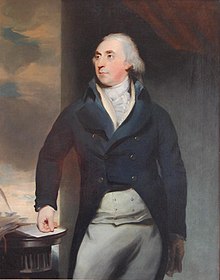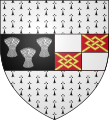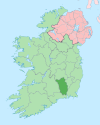Portal:County Kilkenny
The County Kilkenny Portal
County Kilkenny (Irish: Contae Chill Chainnigh) is a county in Ireland. It is in the province of Leinster and is part of the Southern Region. It is named after the city of Kilkenny. Kilkenny County Council is the local authority for the county. At the 2022 census the population of the county was 103,685. The county was based on the historic Gaelic kingdom of Ossory (Osraighe), which was coterminous with the Diocese of Ossory. (Full article...)
Selected articles
Cerball mac Dúnlainge (patronymic sometimes spelled Dúngaile, Irish: [ˈcaɾˠuːl̪ˠ mək ˈd̪ˠuːn̪ˠl̪ˠəɲə]) (died 888) was king of Ossory in south-east Ireland. The kingdom of Ossory (Osraige) occupied roughly the area of modern County Kilkenny and western County Laois and lay between the larger provincial kingdoms of Munster and Leinster.
Cerball came to prominence after the death of Fedelmid mac Crimthainn, King of Munster, in 847. Ossory had been subject for a period to the Eóganachta kings of Munster, but Feidlimid was succeeded by a series of weak kings who had to contend with Viking incursions on the coasts of Munster. As a result, Cerball was in a strong position and is said to have been the second most powerful king in Ireland in his later years. Upon his death, he was succeeded by his brother Riagan mac Dúnlainge.
Kjarvalr Írakonungr (Old Norse: [ˈkjɑrˌwɑlz̠ ˈiːrɑˌkonoŋɡz̠]; Modern Icelandic: Kjarvalur Írakonungur [ˈcʰarˌvaːlʏr ˈiːraˌkʰɔːnuŋkʏr̥]), a figure in the Norse sagas who appears as an ancestor of many prominent Icelandic families, is identified with Cerball. (Full article...)
Selected history articles

Osraige (Old Irish) or Osraighe (Classical Irish), Osraí (Modern Irish), anglicized as Ossory, was a medieval Irish kingdom comprising what is now County Kilkenny and western County Laois, corresponding to the Diocese of Ossory. The home of the Osraige people, it existed from around the first century until the Norman invasion of Ireland in the 12th century. It was ruled by the Dál Birn dynasty, whose medieval descendants assumed the surname Mac Giolla Phádraig.
According to tradition, Osraige was founded by Óengus Osrithe in the 1st century and was originally within the province of Leinster. In the 5th century, the Corcu Loígde of Munster displaced the Dál Birn and brought Osraige under Munster's direct control. The Dál Birn returned to power in the 7th century, though Osraige remained nominally part of Munster until 859, when it achieved formal independence under the powerful king Cerball mac Dúnlainge. Osraige's rulers remained major players in Irish politics for the next three centuries, though they never vied for the High Kingship. In the early 12th century, dynastic infighting fragmented the kingdom, and it was re-adjoined to Leinster. The Normans under Strongbow invaded Ireland beginning in 1169, and most of Osraige collapsed under pressure from Norman leader William Marshal. The northern part of the kingdom, eventually known as Upper Ossory, survived intact under the hereditary lordship until the reign of King Henry VIII of England, when it was formally incorporated as a barony of the same name. (Full article...)
Selected landmarks articles
The Black Abbey of Kilkenny, Ireland, is a Catholic priory of the Dominican Order, dedicated to the Holy and Undivided Trinity. Black Abbey was established in 1225 as one of the first houses of the Dominican Order in Ireland.
The history of the Black Abbey is marked by several reversals of fortune under different governments. (Full article...)
Selected geography articles
Ida (Irish: Uí Dheá) is a barony in the south-east of County Kilkenny, Ireland. Ida is made up of 16 civil parishes containing 191 townlands, it is one of 12 baronies in the County. The barony is 249.8 square kilometres (96.4 sq mi) in size, with highest point at Tory Hill. The chief town is Slieveroe. The N25 crosses the barony. (Full article...)
Moneenroe (from Irish An Móinín Rua, meaning "the little red bog") is a townland, electoral division and village in north County Kilkenny, Ireland. It is located in the province of Leinster along the N78 road about 21 kilometres (13 mi) from Kilkenny city in the south-east of the island of Ireland. , the population of Moneenroe was 722. (Full article...)
The River Suir (/ʃʊər/ SHOOR; Irish: an tSiúr [ənʲ ˈtʲuːɾˠ] or Abhainn na Siúire [ˌəun̠ʲ n̪ˠə ˈʃuːɾʲə]) is a river in Ireland that flows into the Atlantic Ocean through Waterford after a distance of 185 kilometres (115 mi). The catchment area of the Suir is 3,610 km2. Its long term average flow rate is 76.9 cubic metres per second (m3/s), about twice the flow of either the River Barrow (37.4 m3/s) or the River Nore (42.9 m3/s) before these join, but a little less than the Barrow's flow when it meets the Suir 20 km downstream (over 80 m3/s). (Full article...)
The South Leinster Way is a long-distance trail in Ireland. It is 104 kilometres (65 miles) long and begins in Kildavin, County Carlow and runs through County Kilkenny before ending in Carrick-on-Suir, County Tipperary. It is typically completed in five days. It is designated as a National Waymarked Trail by the National Trails Office of the Irish Sports Council and is jointly managed by Carlow County Council, Kilkenny County Council, Tipperary County Council, Carlow Local Sports Partnership, Kilkenny Trails and Coillte. It was opened on 30 November 1985 by Donal Creed, Minister of State for Sport. (Full article...)
Selected quotation
There once was two cats of Kilkenny
Each cat thought there was one cat too many So they fought and they fit And they scratched and they bit 'Til instead of two cats there weren't any. |
— |
Selected Did you know

- ... that Blessed Edmund Ignatius Rice was the founder of two institutes of religious brothers, the Congregation of Christian Brothers and the Presentation Brothers.?
- ... that the Statutes of Kilkenny were a series of thirty-five acts passed at Kilkenny in 1366, aiming to curb the decline of the Hiberno-Norman Lordship of Ireland. (Full article...)
Selected slideshow image
Selected biography articles

William Brabazon Ponsonby, 1st Baron Ponsonby (of Imokilly), PC (Ire) (15 September 1744 – 5 November 1806) was a leading Irish Whig politician, being a member of the Irish House of Commons, and, after 1800, of the United Kingdom parliament. Ponsonby was the son of the Hon. John Ponsonby, the Speaker of the Irish House of Commons and Lady Elizabeth Cavendish, daughter of the 3rd Duke of Devonshire. He was invested as a Privy Counsellor of Ireland in 1784. He served as Joint Postmaster-General of Ireland (1784–1789). (Full article...)
Abraham Colles (23 July 1773 – 16 November 1843) was Professor of Anatomy, Surgery and Physiology at the Royal College of Surgeons in Ireland (RCSI) and the President of RCSI in 1802 and 1830. A prestigious Colles Medal & Travelling Fellowship in Surgery is awarded competitively annually to an Irish surgical trainee embarking on higher specialist training abroad before returning to establish practice in Ireland. (Full article...)
Thomas F. Kilroy (23 September 1934 – 7 December 2023) was an Irish playwright and novelist. (Full article...)
William Ulick O'Connor Cuffe, 4th Earl of Desart (10 July 1845 – 15 September 1898). He succeeded to the title of 6th Baron Desart, 4th Viscount Desart and 4th Earl of Desart on 1 April 1865 (Full article...)
Selected sport articles
Maeve Esther "Flumpy" Enid Kyle, OBE, née Shankey (born 6 October 1928), is an Irish Olympic athlete and hockey player. She was born in Urlingford, County Kilkenny.
She competed in the 100m and 200m in the Melbourne Olympics and subsequently in the Rome Olympics and Tokyo Olympics (where she reached the semi-finals of both the 400m and 800m). She took bronze in the 400m at the 1966 European Indoor Athletics Championships in Dortmund. (Full article...)
Related portals
Associated Wikimedia
The following Wikimedia Foundation sister projects provide more on this subject:
-
Commons
Free media repository -
Wikibooks
Free textbooks and manuals -
Wikidata
Free knowledge base -
Wikinews
Free-content news -
Wikiquote
Collection of quotations -
Wikisource
Free-content library -
Wikiversity
Free learning tools -
Wikivoyage
Free travel guide -
Wiktionary
Dictionary and thesaurus






























































